First aid - Shock:
What is shock:
Shock is what happens when the heart and blood vessels are unable to pump enough oxygen-rich blood to the vital organs of the body. Although every illness and involves shock to some degree, it can be a life threatening problem. The best way to protect people from the serious damages that shock can have on the system is to recognize the signs before the person gets into serious trouble. In most cases, only a few of the symptoms will be present, and many do not appear for some time.
Classification of shock:
Hypovolemic Shock: This form of shock is brought on by a decrease in the amount of blood vessels or other fluids in the body. Excessive bleeding from internal and external injuries, fluid loss due to diarrhea, burns, dehydration, and severe vomiting usually cause this kind of shock.
Neurogenic Shock: In the case of neurogenic shock, the blood vessels become abnormally enlarged and the pooling of the blood disallows an adequate blood flow to be maintained. Fainting is an example of this sort of shock, as the blood temporarily pools as the person stands. When the person falls the blood rushes back to the head and the problem is solved.
Psychogenic Shock: This shock is more common, and is known as a “shock like condition”. It is produced by excessive fear, joy, anger, or grief. “Shell shock” is a psychological adjustment reaction to stressful wartime experiences. Treatment for shell shock is limited to emotional support and help from a medical facility.
Anaphylactic Shock: This form of shock is brought on by an allergic reaction from a food, bee sting or other insect bite, and inhalants. For more information on the care and treatment click the link below. Anaphylactic Shock
The most common symptoms are: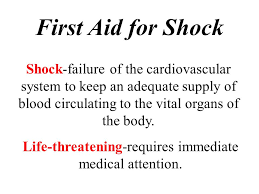
- Pale, cold, clammy and moist skin
- Vacant or dull eyes, dilated pupils
- Anxiety, restlessness, and fainting
- Weak, rapid, or absent pulse
- Shallow, rapid, and irregular breathing
- Nausea and vomiting
- Excessive thirst
- Person may seem confused or tired
- Loss of blood pressure
causes of shock:
There are several main causes of shock:
- Heart conditions (heart attack, heart failure)
- Heavy internal or external bleeding, such as from a serious injury or rupture of a blood vessel
- Dehydration, especially when severe or related to heat illness.
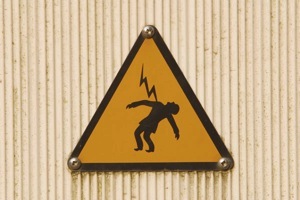
- Infection (septic shock)
- Severe allergic reaction (anaphylactic shock)
- Spinal injuries (neurogenic shock)
- Burns
- Persistent vomiting or diarrhea
Treatment of shock:
1. Call your local emergency help provider for help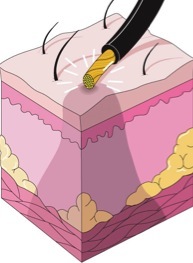
2. Lay the victim face up, on a blanket or coat if possible, and raise the feet above the head unless they are fractured. If the person is bleeding from the mouth or vomiting, tilt their head to the side to avoid fluids going into the lungs and airways. If you are unsure of injuries keep the person laying flat.
3. Loosen tight clothing, braces, belts, jewelry etc to avoid constriction of the waist, neck and chest.
4. Keep the victim comfortable and warm enough to be able to maintain their own body heat. If possible, remove wet clothing and place blankets beneath the victim. NEVER use artificial sources of heat. If they are bleeding severely do not apply heat to the wounded area as it will prevent the blood from clotting as easily
5. Check for other injuries, such as bleeding and burns and treat the other injuries according to first aid procedures. If possible try to splint sprains or broken bones. If you are unsure of how to do this, leave them as they are to avoid further damage.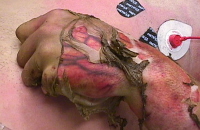
6. If they claim they are thirsty moisten their lips with water but DO NOT give them anything to drink, as it may induce vomiting.
7. Try to keep the victim calm, excitement and excessive handling will worsen their condition try to assure them help is on the way.
Remember, if you can perform these actions before shock has completely developed you may prevent its occurrence and if it had developed you may stop it from becoming fatal. If shock is left unattended to the victim will die, it is extremely important that first aid be performed as soon as possible.
Self-Care at Home:
- Call emergency for immediate medical attention any time a person has symptoms of shock. Do not wait for symptoms to worsen before calling for help. Stay with the person until help arrives, and if possible, stay on the line with the emergency dispatcher because they may have specific instructions for you.
- While waiting for help or on the way to the emergency room, check the person's airway, breathing and circulation (the ABCs). Administer CPR if you are trained. If the person is breathing on his or her own, continue to check breathing every 2 minutes until help arrives.
- Do NOT move a person who has a known or suspected spinal injury (unless they are in imminent danger of further injury).
- Have the person lie down on his or her back with the feet elevated above the head (if raising the legs causes pain or injury, keep the person flat) to increase blood flow to vital organs. Do not raise the head.
- Keep the person warm and comfortable. Loosen tight clothing and cover them with a blanket.
- Do not give fluids by mouth, even if the person complains of thirst. There is a choking risk in the event of sudden loss of consciousness.
- Give appropriate first aid for any injuries.
- Direct pressure should be applied to any wounds that are bleeding significantly.
What is the outlook for shock?
Prompt treatment of medical shock is essential for the best outcome. Moreover, the outlook depends on the cause of the shock, the general health of the patient, and the promptness of treatment and recovery.
- Generally, hypovolemic shock and anaphylactic shock respond well to medical treatment if initiated early.
- Septic shock is a serious condition with a mortality rate of 24% to 50% according to some estimates. The sooner the infection is treated and fluids are administered, the greater the chances of success. Hospitals are now developing and utilizing specific protocols to identify and aggressively treat septic shock patients.
- Cardiogenic shock has a poor prognosis, with only 1/3 of patients surviving. Because this type of shock results from injury or dysfunction of the heart it is often difficult to treat and overcome.
- Spinal shock also has a very poor prognosis because the spinal cord mediates so many important bodily functions. There are currently very few effective treatments but medical research is making advances in the treatment of spinal injuries.
How Does Electric Shock and Lightning Work: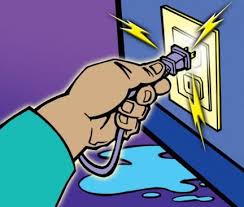
- An electric shock occurs when a person comes into contact with an electrical energy source.
- Electrical energy flows through a portion of the body causing a shock.
- Exposure to electrical energy may result in no injury at all or may result in devastating damage or death.
- Many people get electric shocks obtained from man-made objects such as electrical appliances, electrical wires, and electrical circuitry.
- In addition, lightning strikes are a natural form of electric shock.
- Burns are the most common injury from electric shock and lightning strikes.
Electric Shock Causes:
Electrical injury can be caused by:
- Accidental contact with exposed parts of electrical appliances or wiring
- Flashing of electric arcs from high-voltage power lines
- Lightning
- Machinery or occupational-related exposures
- Young children biting or chewing on electrical cords, or poking metal objects into an electrical outlet
Symptoms:
Symptoms depend on many things, including:
- Type and strength of voltage
- How long you were in contact with the electricity
- How the electricity moved through your body
- Your overall health
Symptoms may include:
- Changes in alertness (consciousness)
- Broken bones
- Heart attack (chest, arm, neck, jaw, or back pain)
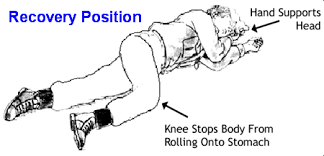
- Headache
- Problems with swallowing, vision, or hearing
- Irregular heartbeat
- Muscle spasms and pain
- Numbness or tingling
- Breathing problems or lung failure
- Seizures
- Skin burns
First Aid:
1. If you can do so safely, turn off the electrical current. Unplug the cord, remove the fuse from the fuse box, or turn off the circuit breakers. Simply turning off an appliance may NOT stop the flow of electricity. Do NOT attempt to rescue a person near active high-voltage lines.
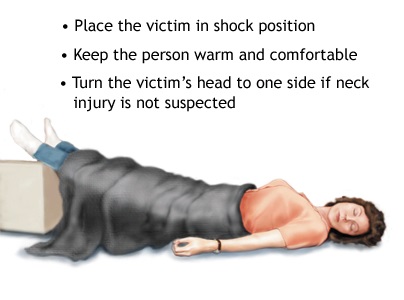
2. Call your local emergency number, such as emergency.
3. If the current can't be turned off, use a non-conducting object, such as a broom, chair, rug, or rubber doormat to push the person away from the source of the current. Do not use a wet or metal object. If possible, stand on something dry that doesn't conduct electricity, such as a rubber mat or folded newspapers.
4. Once the person is away from the source of electricity, check the person's airway, breathing, and pulse. If either has stopped or seems dangerously slow or shallow, start first aid.
5. If the person has a burn, remove any clothing that comes off easily and rinse the burned area in cool, running water until the pain subsides. Give first aid for burns.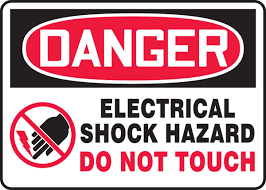
6. If the person is faint, pale, or shows other signs of shock, lay him or her down, with the head slightly lower than the trunk of the body and the legs elevated, and cover him or her with a warm blanket or a coat.
7. Stay with the person until medical help arrives.
8. Electrical injury is frequently associated with explosions or falls that can cause additional severe injuries. You may not be able to notice all of them. Do not move the person's head or neck if the spine may be injured.
9. If you are a passenger in a vehicle struck by a power line, remain in it until help arrives unless a fire has started. If necessary, try to jump out of the vehicle so that you do not maintain contact with it while also touching the ground.
DO NOT:
Stay at least 20 feet away from a person who is being electrocuted by high-voltage electrical current (such as power lines) until the power is turned off.
- Do NOT touch the person with your bare hands if the body is still touching the source of electricity.
- Do NOT apply ice, butter, ointments, medicines, fluffy cotton dressings, or adhesive bandages to a burn.
- Do NOT remove dead skin or break blisters if the person has been burned.
- After the power is shut off, do NOT move the person unless there is a risk of fire or explosion.
Prevention:
- Avoid electrical hazards at home and at work. Always follow the manufacturer's safety instructions when using electrical appliances.
- Avoid using electrical appliances while showering or wet.
- Keep children away from electrical devices, especially those that are plugged in to an electrical outlet.
- Keep electrical cords out of children's reach.
- Never touch electrical appliances while touching faucets or cold water pipes.
- Teach children about the dangers of electricity.
- Use child safety plugs in all electrical outlets.
Click the below link to know more in details about CPR , AED procedures and its videos

Automated External Defibrillator (AED)
First aid- Shock and bleeding
First aid- Shock